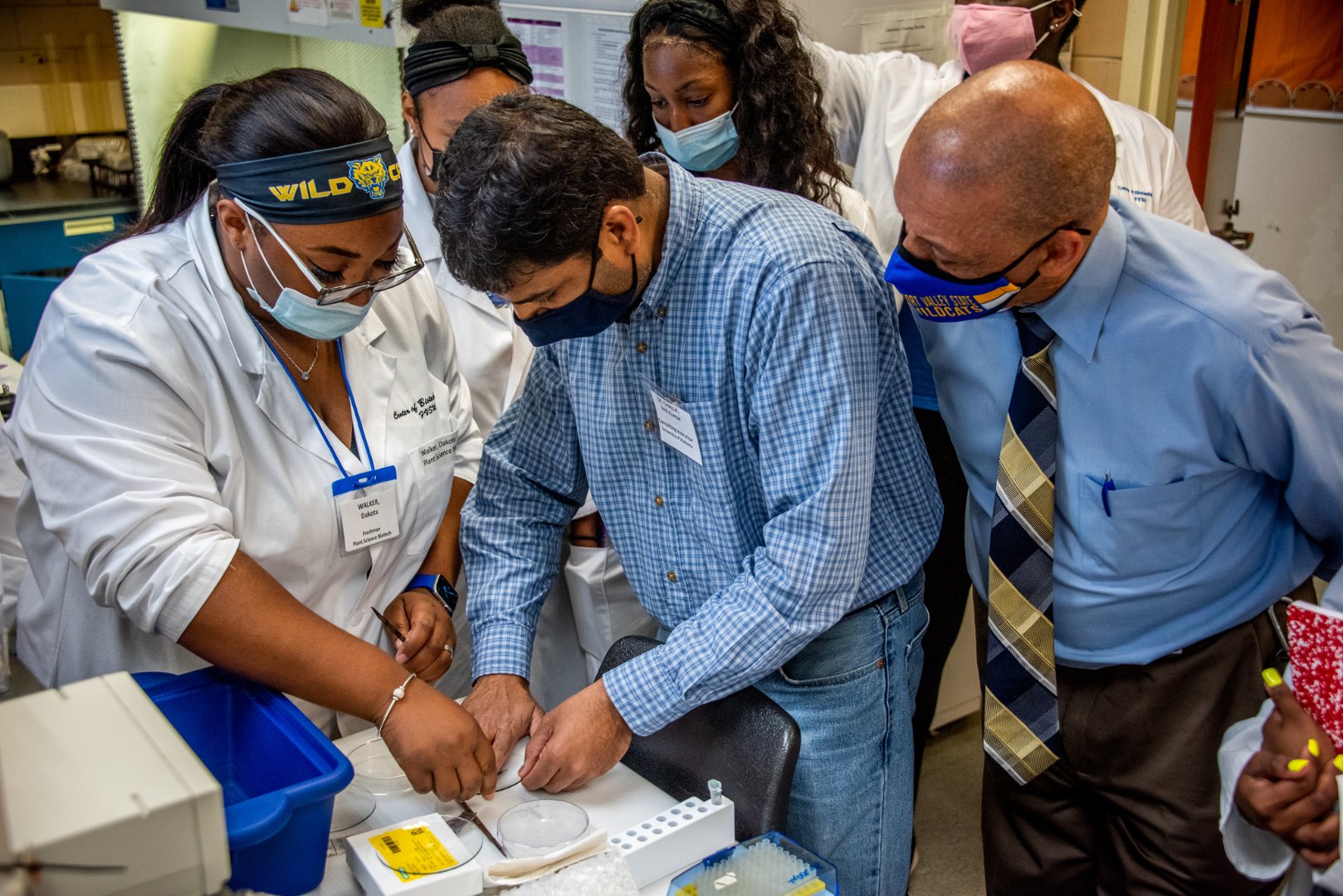Fort Valley State University’s Center for Biotechnology recently hosted a four-day workshop about gene editing with CRISPR (clustered regularly interspaced short palindromic repeats) technology.
The experience for STEM (science, technology, engineering and mathematics) students was structured as a combination of lectures and discussions with hands-on laboratory instruction using gene editing technology to modify, delete or correct precise regions of DNA. Topics included introductions to basic CRISPR/Cas9 cell engineering workflow from design and synthesis of target specific guide RNAs (gRNAs) to analysis of gene editing efficiency.
Dr. Sarwan Dhir, plant science professor and director of the Center of Biotechnology, selected 15 students to participate in the interactive research experience led by genome editing expert Dr. Anil Kumar Challa, professor at the University of Alabama at Birmingham. FVSU associate professors Seema Dhir, Celia Dodd and Kaneatra Simmons from the biology department also assisted.
Dhir believes early hands-on exposure to advanced laboratory experiments benefits FVSU first- and second-year college science majors.
“Nine of the 15 students were freshmen and sophomores. Witnessing their confidence grow in conducting hands-on lab activities in advanced gene editing techniques was rewarding,” he said. “As an underrepresented group in STEM, it’s imperative that minority students receive opportunities to learn from the expertise of leading scientists. Research such as CRISPR/Cas9 will positively impact the medical to agricultural landscape.”
The CRISPR/Cas9 system edits genes by precisely cutting DNA and then letting natural DNA repair processes to take over. The system consists of two parts – the Cas9 enzyme and a guide RNA.
Challa, who is a research instructor with a doctorate degree in molecular genetics, said an important aspect of the workshop was to help students understand the historical context of the discovery and use of this technology through the reading of a recent book, “Editing Humanity” by Dr. Kevin Davies.

“I have had the opportunity to work with the CRISPR system since 2014,” said Challa, who has postdoctoral research experience in glycobiology, RNA biology and vascular biology. “I learned a lot through several projects focused on editing genes in zebrafish, mice, rats and human cells. It has been an exciting journey so far, and I keep learning every day as the technology moves forward at a fast pace.”
The research instructor emphasized that gene editing using CRISPR technology is a new tool in an experimental biologist’s toolkit to understand gene function and seek solutions to treat genetic diseases.
“Another important aspect of this type of research shows how a deep and careful study of basic biological phenomena can lead to technological breakthroughs that can be put to beneficial uses,” he added.
Through the workshop, Dhir and Challa aimed for FVSU students to appreciate the discovery process involved in the CRISPR revolution and learn the underlying molecular biology concepts clearly. In addition, they hoped the students would gain some skills of designing and executing experiments in the laboratory, as well as learn to synthesize and communicate this knowledge effectively.
At the conclusion of the workshop, students delivered five-minute presentations on founding researchers’ CRISPR technology contributions and discussed gene editing impact factors. They also shared this knowledge with FVSU President Dr. Paul Jones, who was impressed with their scholarship and passion.
Freshman Anaya Arnold of Covington, Georgia, said the CRISPR workshop helped her gain an understanding of how this fairly new technology can be used to cure a disease in weeks rather than months. It also helped her understand how DNA binds together.
The plant science-biotechnology major recalled participating in an interactive activity where she and her classmates pretended to be adenine, cytosine, thymine and guanine. They created a strand and then bonded with their other pair (adenine and thymine; guanine and cytosine).
The 18-year-old said she can apply this knowledge and skills in the classroom by teaching her peers how to complete the sgRNA synthesis, which is the guide RNA. Furthermore, it could benefit her future career as an obstetrician-gynecologist.
“This technology can be applied in my career by activating the function of genes that can potentially cause diseases to determine which protein causes and/or prevents the given disease,” Arnold said.
The future is bright for this young scientist, who will intern at the University of Georgia in summer 2021. Her educational goals include pursuing a doctorate at Morehouse School of Medicine.
Multimillion-dollar grants from the National Science Foundation (NSF) HBCU-UP (HRD-2011903), S-STEM (DUE-1834046) and the Department of Education MSEIP (P120A2000016) at FVSU funded the workshop.

